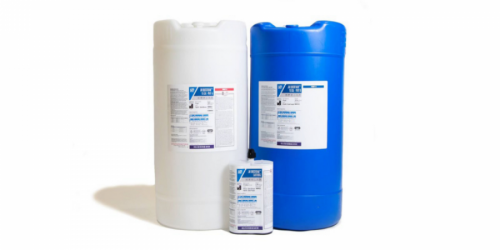Q&A Forums
shrinkage Post New Topic | Post Reply
| Author | Comments |
|---|---|
|
Harry S
Posted: Sep 09, 2009 04:21 PM
|
shrinkage
Mason...is it possible that osb has enough moisture in it in a stickframed walkout (approx. 30yr old) that 2# cc would suck that moisture out & shrink from the outside in? It's a rehab job, weather was 75 degrees with no humidity, foam sprayed super, they didn't drywall for over a week, 2 weeks later they called & said they were replacing windows on main level and ended up tearing off osb on lower level only to discover foam had shrunk from the outside! It was still adhered to the studs on the inside and the drywallers saw no daylight or shrinkage when they were hanging. I talked to 2 different tech reps & they both shared the same theory. What's your thoughts? Any input from anybody would be appreciated. Thanks in advance.
|
|
mason
Posted: Sep 10, 2009 07:48 AM
|
A high moisture content of the wood during application would affect the physical properties and the dimensional stability of the foam. But, after the foam is installed, there should not be a problem as you described. I suspect the shrinking foam is caused by other factors that would cause it to have weaker cell structure or more open cells. Some 2 lb sprayfoam formulas are more dimensionally stable than others but there are ways to minimize the potential for shrinking foam no matter whose foam you use. 1. Picture frame the studs and wait 5- 10 minutes before installing your first lift. This adds a high density skin on the surface of the stud that helps to reinforce the adhesion to the stud 2. Spray the full length of the stud instead of back and forth. This technique reduces the potential for shrinkage away from the studs. 3. Spray in lifts between 0.5 to 1.5 inches in thickness and wait 10-15 minutes between lifts. This reduces the heat of the exothermic reaction taking place within the foam. The more heat (abouve 220 degrees F) the more likely the foam's cell structure will be weak and you will have more open cells, thereby reducing the dimensional stability of the foam. To measure the temperature of your curing foam. After you spray a sample of foam use a thermometer to check the interior temperature of the foam at various thickness. Stay below 220 degrees F with your thickness. It may vary depending on the ambient temperature, substrate temperature and material temperature, and type of material. 4. Check the moisture content of the substrate. Sometimes the wood is wet and you can't see or feel it. Use a moisture meter or moisture detecting strips. Moisture content on wood or OSB should be less than 19%. 5. Check for contamination of the substrate. Sometimes OSB has special treatments for insects or moisture that may affect adhesion or react with the foam during application. Spray a small section first and look at the cell structure of the foam. If there is a distinct reaction at the substrate/foam interface (hairy like filaments, elongated cell stucture, shiny surface, etc.) you probably need to clean or prime the substrate. 5. Make sure you have a good mix at the gun. Sometimes a mixing nozzle or tip may be too large for the application and pressure is reduced to compensate for it. If this is the case, you need to reduce the nozzle, mixing chamber or tip size. An inadequate mix may look like good foam but will leave too many open cells that lead to poor dimensional stability. 6. Check your air for moisture. Sometimes your compressor can get water in the tank from condensation and your water traps and filters are inadequate to take the water out. This water goes throught the airline and is spread on the substrate during application. 7. Use a higher density foam in extreme climates (both hot and cold). Typically the higher the density, the greater the dimensional stability of the foam. 8. Do a "thumb check" of the foam during application. A 2 lb density foam should not be easily compressed when light pressure is exerted on the foam. It takes a more significant effort to compress the foam. If you have strong and weak spots in the foam it is an indication of slightly off ratio or a poor mix of foam. In order for your supplier to assist with troughbleshooting the problem, make sure you have good job records. The following information can assist you in these determinations: 1. Check ambient temperature, humidity and substrate moisture content. (3 times daily or at each start-up) 2. Equipment pressure and temperature settings (hose, preheater during application (3 times daily or during each start up) 3. Lot numbers of material, thickness of application and where it was sprayed 4. Applicators (who sprayed what). Record an anomalies of the foam application and report them to your supplier. Ask for their recommendations in writing. |
|
Posted: Sep 11, 2009 06:59 AM
|
,,,,thinkin outloud,,, first ask the applicator to be honest,,like maybe after a few beers on a friday afternoon,, did he go of ratio resin rich at any time on the job...(like maybe in this area???)if so did he remove the resin rich foam from the wall,,,or did he correct the maladjusted equip and hammer on and over the "small,tiny area" of resin rich foam...("thought it wouldn matter" is what you will hear if they are up wiff ya) moisture in osb could affect adhesion..but this would not look like shrinkage,,,it would be good foam that lost its connection to the wood cause it aint stuck too good... suck the moisture out???uh,,we are creating a thermo set plastic,,,and this just dont happen with thermo set plastics after they have been manufactured and cured properly.... now then,,if there was gross water on the substrate,,indeed shrinkage could occur,,but this would be apparrent at the time of application due to messin with the chemistry... check your lot numbers and manufacture dates,,,have there been similar episodes with the same lot and date? could it be a resin malady??? chemical??mechanical??a combo of both??? oohh and it makes me wonder,,, |
|
Michael Fusco
Posted: Sep 11, 2009 05:24 PM
|
"Foam had shrunk from the outside" Could that be voids behind open cell foam? Usually applicator issue (see foamdude's post). Can also be as simple as trapping steam behind the lift, spraying bottom to top...... |
|
Michael Fusco
Posted: Sep 11, 2009 05:26 PM
|
oops...sorry....misseed the 2# cc statement. Steam behind the lift still a possibility. |





























